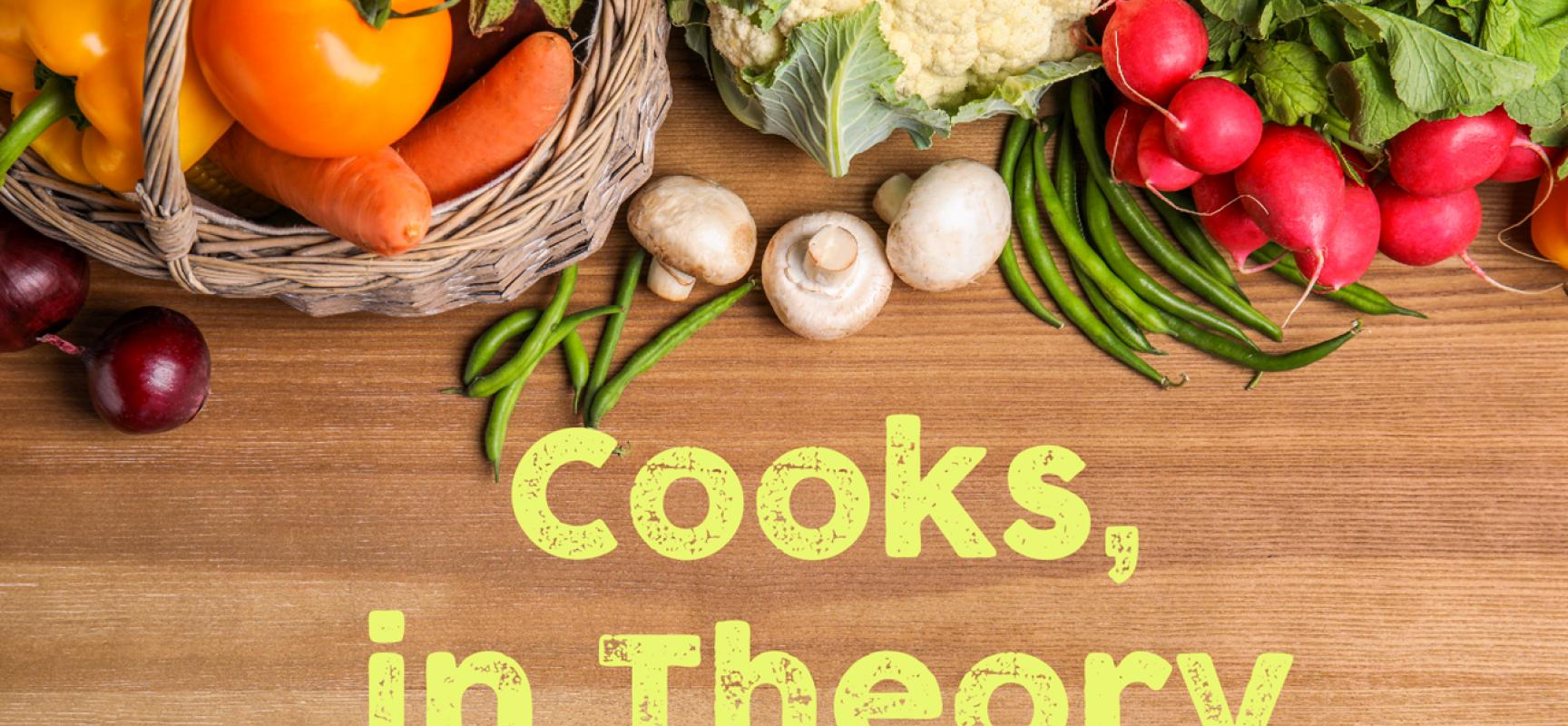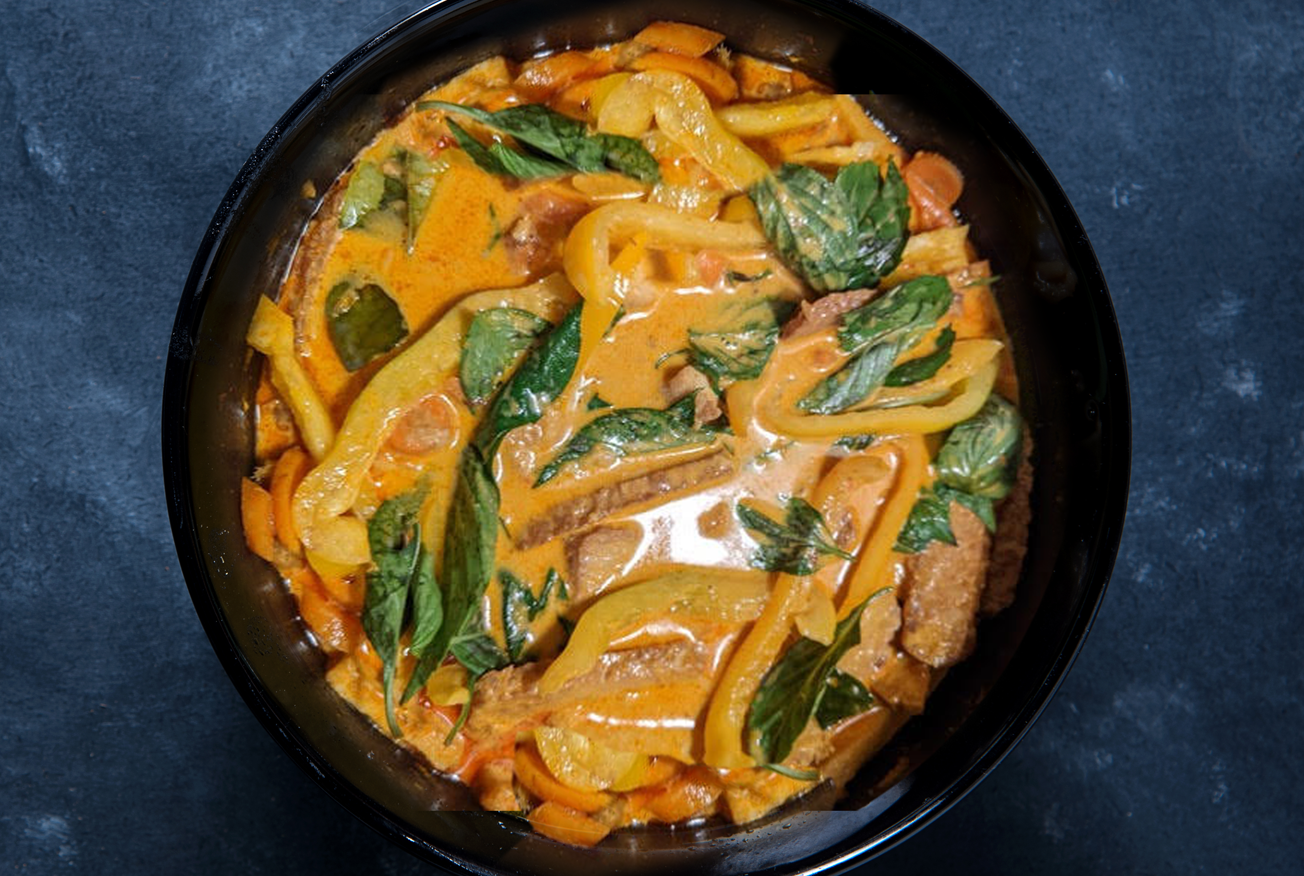Cooks, in Theory

Series edited by Amy Ambrose (Simons Institute)
Primer and recipe by Daniel Mitropolsky (Columbia University)
Earlier this fall, we invited guest chef Daniel Mitropolsky, a PhD student at Columbia University, to teach our Cooks, in Theory cooking club the proper way to make Thai curry — something that he has spent a great deal of time getting right. His recipe alone is a work of culinary art. It speaks to our mission to demystify cooking and share something fun and healthy (and really delicious) as a community. We honor Daniel’s efforts by encouraging you to read all the way through the primer as well as the recipe. You will thank yourself!
Thai Curry 101
This is an opportunity to learn how to make Thai curry (gaeng) and also to learn about Thai cooking techniques and Thai ingredients (how to stock a Thai pantry). Some authentic Thai ingredients are notoriously hard to get in the U.S., so I thought it might be hard for everyone to procure every ingredient. I've therefore organized the ingredients into tiers of how important they are. Get the mandatory ingredients, and if you can, get as many non-mandatory ingredients as possible. Note: See "Glossary” after lists for a thorough explanation of each ingredient. Do not purchase before reading the glossary.
Mandatory ingredients
2 cups coconut milk
Red curry paste or panang curry paste
1-2 cups broth (I am using vegetable broth, but chicken or pork broth are fine and traditional.)
1 package firm tofu and 1 package tempeh (optional: substitute chicken, pork, or beef)
Several carrots (whole)
1-2 bell peppers (red, orange, or yellow)
Fish sauce
Rice (preferably Thai jasmine rice; brown rice is great as well — prepare separately beforehand or while cooking the curry)
I will show you how I prepare tofu and tempeh with an Indonesian method, which while not traditionally Thai, is delicious.
Optional but highly recommended ingredients
One bunch Thai basil (horapa)
Handful of kaffir lime leaves
Several cloves of fresh garlic
An inch or two of fresh ginger
Thai red chilis or other chilis
I will show you how to add fresh garlic and ginger to a store-bought curry paste to enhance the store paste. I will be using a stone mortar and pestle for this. This step is optional.
Completely optional ingredient
Thai shrimp paste (kapi)
Glossary
Coconut milk. In the U.S., most coconut milk that you can find is canned. Canned coconut milk does not exist in Thailand, and it is definitely worse than coconut milk in packets (which is how it is sold in Thailand). In addition to flavor and freshness, one distinguishing characteristic in coconut milks is whether they will crack (when the oil separates from the rest of the liquid through simmering) or not — an essential step in preparing Thai curry correctly. Sadly, many lower-quality canned coconut milks have been homogenized in a way that prevents them from ever cracking. Now, if you are lucky, your Asian grocery store might have coconut milk in packets, probably from Aroy-D, which is a Thai company. You have struck the jackpot. This coconut milk is extremely delicious and can be used in a variety of recipes and in your daily life — it also will always crack. You can also order it online from Amazon. If you are buying canned coconut milk, go for the most expensive, organic, and fancy option available. This is because not only will it taste better, but it is more likely to crack. If you end up buying a coconut milk that does not crack, not all is lost — and your curry will come out just fine — but it is worth putting some effort into this step.
Curry paste. Many companies produce and sell ready curry paste in the U.S.; you will probably go with what is available at your grocery store. For this recipe, buy a red or panang curry paste, though this technique also applies to other kinds of Thai curries. Aroy-D, Mae Ploy, and Maesri all make good curry pastes. Curry pastes are often sold in cans, paper cups, and even plastic bags; none of this makes a difference. You might want to look at the ingredient list and make sure the curry paste doesn't include weird preservatives, artificial color, etc. All good curry pastes should minimally have shallot, lemon grass, garlic, chilies, galangal, and spices; more “advanced” (read: better) curry pastes will have kaffir lime peel, white pepper, cilantro root, and shrimp paste; all of these are signs of an excellent curry paste. Don't worry if what you find has only the “basic” ingredients; we are, alas, not in the markets of Bangkok.
Fish sauce. The most important part of stocking a Thai pantry is selecting a good fish sauce. If you are new to fish sauce, prepare to have your life be changed for the better. Fish sauce is an ingredient in almost every Thai dish and is the main salting agent (not salt). It is also essential in Vietnamese, Burmese, Malay, and Indonesian cuisines. I also use it in salads and other “fusion” dishes all the time. It is worth investing in a good fish sauce. No matter what anyone tells you, the best way to select a fish sauce is to look directly at the ingredients: the best, purest, and rarest fish sauce will have only anchovy and salt. It should also be made in Vietnam or Thailand, the kings of fish sauce production. Red Boat is a Vietnamese company that makes pure fish sauce that is absolutely delicious — I could have it by the spoon. Squid brand (Thai) and Three Crabs (Vietnamese) are also good, even though they are not pure. You might encounter a strange-looking bottle with a brand you've never heard of but with the magic ingredient list of just anchovy and salt; don't hesitate, because the ingredient list is ultimately the best metric.
Kaffir lime leaves. These are a classic and essential herb in Thai cookery that gives dishes that unique, melon-like Thai flavor. Most Asian stores will have it, but you might be alarmed by finding only a very large package — I would recommend buying this since you can freeze kaffir lime leaves for later. You might find only dried kaffir lime leaves; though worse than fresh ones, these are fine too, and you should buy them if you cannot find fresh.
Shrimp paste (kapi). In Thailand, shrimp paste is an ingredient in all curry pastes, giving them a funky, deep, fermented kick. It is a bit of an acquired taste on its own, but not when a bit is added to curry paste. In the U.S., I have never found a premade curry paste with kapi in it; I suspect this is because companies prefer to sell a vegetarian product. Since I have some, I will add a little bit to the curry paste to make it more authentic, but this is totally optional. You can order Thai shrimp paste online.
Thai basil (horapa). Thai basil is not regular (“Genovese”) basil, and regular basil should not be substituted for it. The flavors are substantially different. Thai basil is a great ingredient to become acquainted with and have around in general; many prefer it to Italian basil because it is a bit sweeter and more “rounded.” Also, Thai basil (horapa) is not the same thing as Thai holy basil (kaphrao), a very rare and delicious plant that I have never found in New York.
FAQ
Q. Can I substitute fish sauce with anything else?
A. Absolutely not. This question is antithetical to Thai cooking. I suppose if you truly could not find fish sauce, you could use salt, but this would be very disappointing. No, soy sauce and rice vinegar are not substitutes for fish sauce.
Q. Can I use vegetables other than carrots/bell peppers?
A. Absolutely. Carrots and (some sort of) pepper are just simple and common ingredients. If you like, go ahead and get sweet potato, pumpkin, butternut squash, or other “hard” vegetables; these will all go great in Thai curry.
Q. Is there a canned or common coconut milk that you recommend and that you know “cracks”?
A. I have transitioned fully to using Thai coconut milk packets, which I order through Amazon. I have had success, however, with Trader Joe's organic full-fat coconut milk; for me, it did indeed crack.
RECIPE
Part 1: “Augmenting” store-bought curry paste
- Add 4-6 whole garlic cloves, an inch of fresh ginger roughly chopped, and several (1-4) Thai red chilies (optional) to mortar and pestle.
- Pound ingredients into a paste; it will be quite wet. The pepper skins are the hardest to pound well.
- Open a can of curry paste and add 2-4 tbsp, depending on the level of spiciness and intensity desired (2 is minimal and mild; 4 will be strong and spicy).
- Add 1/2 teaspoon to 1 teaspoon of kapi (fermented shrimp paste), less for first-timers.
Note: One can also prepare the entire curry paste from scratch; there are many recipes online for this. It can be prepared in advance and frozen for months.
Part 2: Tempeh and tofu
- Cut the tempeh block along the width dimension (the shape you want is this one). The strips should be thin. Cut the tofu into similarly shaped thin strips.
- Heat a neutral vegetable oil (such as soy, canola, peanut, avocado, or sunflower) in your smallest deep pot, enough oil for about 1 inch high.
- When the oil is very hot, introduce tempeh strips and deep-fry in batches (since they won't fit all at once). Optionally, do the same with the tofu (tofu is great unfried as well).
- Remove tempeh/tofu with a slotted spoon, let excess oil drip back into the pot, and then transfer tempeh/tofu to a paper towel-covered plate.
Part 3: Curry
- Add 1/2 cup of coconut milk to a very large saucepan or pot on medium-high heat. The coconut milk should begin reducing quickly and look "netted" on the bottom of the pot. This is normal, but do not let it burn. When it has reduced over 50%, you should hopefully see the milk "crack": clear oil will separate from the white coconut solids and sizzle.
- When the milk cracks, add curry paste and stir to combine. Roast until very fragrant, about 4 minutes. If using animal protein, add it now and stir to coat.
- Add 1 cup of coconut milk and 1 cup of broth. Going forward, you can always add more coconut milk and broth at a 1:1 ratio.
- Let simmer for ~4 minutes, stirring regularly. After trying curry to make sure it is not very salty already, add 1 tbsp fish sauce.
- Add tempeh and tofu, and stir. Taste and adjust fish sauce for saltiness. If the curry is too dense, add more coconut milk and broth to water it down. Cook for 4 minutes.
- Add chopped carrots, cook for a few minutes, and then add the bell peppers. In Thai cuisine, vegetables should be cooked but still crispy — a few minutes is enough!
- Make final milk/broth and fish sauce adjustments, add Thai basil leaves, and immediately turn off heat.
Serve with rice.
If you would like to receive connection details and information on upcoming Cooks, in Theory sessions, please email Raquel Romero at rmromero@berkeley.edu.





